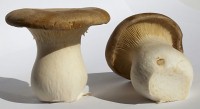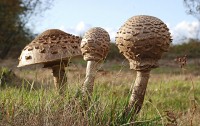A group of researchers from the University of Graz have investigated the arsenic speciation in the most popular cultivated and wild-grown edible mushrooms in Central Europe.
Background:Edible mushrooms are popular around the world, especially in the cuisine of Europe and Asia. According to the information provided by the ‘Food and Agriculture Organization of the United Nations’ (FAO), Europe has the second-largest share of cultivated and collected mushrooms. Mushrooms are chosen for their taste and their high proportion of proteins and other essential or healthy nutrients, but they can also accumulate toxic elements such as cadmium, mercury or arsenic.
Since the toxicity of trace element species depends on the chemical structure, it is not the total element content that is informative for a risk assessment but the distribution of species. This is particular of interest for arsenic, with the inorganic As species (iAs), including arsenite (AsIII) and arsenate (AsV), being usually regarded as the most toxic forms, while some organic species such as arsenobetaine and arsenocholine are considered to be non-toxic or much less toxic. Anyhow, mushrooms show a high diversity in their arsenic species distribution, with even new naturally occurring species being found recently. It is therefore of interest to investigate the arsenic species profile of the most often consumed mushrooms in Europe.
The new study:A group of researchers from the University of Graz have investigated the arsenic speciation in the most popular cultivated and wild-grown edible mushrooms in Central Europe. The total arsenic concentration and speciation of 93 mushroom samples were investigated with inductively coupled plasma mass spectrometry (ICP-MD) and high performance liquid chromatography coupled to ICP-MS.
Total arsenic was determined after digestion with nitric acid in a microwave assisted digestion system held at 250°C for 30 min. Arsenic was measured by ICP-MS with helium in the collision cell. External calibration in the range of 0.1 - 100 µg/L As was performed with germanium as internal standard. Results for the different mushrooms were between < 0.004 to 1.02 mg/kg dry mass.
 | The lowest mean total arsenic value was found in the samples of Pleurotus eryngii (0.004-0.012 mg/kg) |
 | The highest mean total arsenic value was found in Macrolipiota procera (0.54 ± 0.26 mg/kg).
|
While in general the total arsenic mass fraction covers a wide range, the
wild mushroom tends to higher values than the cultivated ones.
For arsenic speciation analysis about 200 mg of each sample was mixed with 4 mL of ultrapure water and sonicated in an ultrasonic bath at room temperature for 15 min. Following extraction, the samples were centrifuged for 10 min and filtered through 0.2 µm Nylon syringe filters. In order to ensure complete oxidation of labile trivalent or thiolated species, one of the extracts of several selected samples was additionally heated at 40°C for 60 min after addition of hydrogen peroxide. Speciation analysis was carried out by HPLC-ICP-MS with an anion-exchange method as well as a cation-exchange method.
External calibration in the range of 0.05-100 µg/L As was performed for each species. For controlling the quality of measurements, iAs was measured in NIST SRM 1640a Water reference materials and the speciation was studied in IPE-120 Agaricus bisporus (WEPAL, Wageningen). Results obtained of these measurements were in good agreement with certified values or published data.
Extraction with water gave good to excellent extraction efficiencies up to 94 % for most samples, except for C. cibarius (only 38 %). The column recovery (ratio between the sum of all species to the total arsenic in the extract) ranged between 79 and 112% with an average recovery of 97%. The most common As species found in the mushroom fruit-bodies were dimethylarsinic acid (DMA), methylarsonic acid (MA), arsenobetaine (AB) and inorganic arsenic (iAs). Less frequently occurring were tetra-methyl-arsonium (TETRA), arsenocholine (AC) and trimethylarsine oxide (TMAO). Some traces of trimethylarsoniopropionic acid (TMAP or AB2), dimethylarsinoylacetic acid (DMAA) and homoarsenocholine (AC2) could also be detected, besides several unknown As species. In general, the As speciation was similar for samples of the same mushroom species. Yet, the distribution of As species was quite different for different mushroom types.
When evaluating the health risk related to the arsenic species being found, the authors concluded that for the worst case scenario, still 2 kg of mushrooms could be consumed per day.
 The original publication
The original publication
Martin Walenta, Simone Braeuer,
Walter Goessler, Arsenic speciation of commonly eaten mushrooms from central Europe, Environ. Chem., 20/1-2 (2023) 66-73.
DOI: 10.1071/EN22069
 Used Instrumentation:
Used Instrumentation:
 Related studies (newest first):
Related studies (newest first):

J. Zhang,
D. Barałkiewicz, Y. Wang, J. Falandysz, C. Cai,
Arsenic and arsenic speciation in mushrooms from China: A review. Chemosphere 246 (2020) 125685.
DOI: 10.1016/j.chemosphere.2019.125685
H. Zou, C. Zhou, Y. Li, X. Yang, J. Wen, S. Song, C. Li, C. Sun,
Speciation analysis of arsenic in edible mushrooms by high- performance liquid chromatography hyphenated to inductively coupled plasma mass spectrometry. Food Chem., 327 (2020) 127033.
DOI: 10.1016/j.foodchem.2020.127033
M.-Y. Li, P. Wang, J.-Y. Wang, X.-Q. Chen, D. Zhao, D.-X. Yin, J. Luo, A.L. Juhasz, H.-B. Li, L.Q. Ma, Arsenic Concentrations,
Speciation, and Localization in 141 Cultivated Market Mushrooms: Implications for Arsenic Exposure to Humans. Environ. Sci. Technol., 53 (2019) 503–511.
DOI: 10.1021/acs.est.8b05206
I. Komorowicz, A. Hanć, W. Lorenc,
D. Barałkiewicz, J. Falandysz, Y. Wang,
Arsenic speciation in mushrooms using dimensional chromatography coupled to ICP-MS detector. Chemosphere, 233 (2019) 223–233.
DOI: 10.1016/j.chemosphere.2019.05.130
S. Braeuer,
W. Goessler, Arsenic species in mushrooms, with a focus on analytical methods for their determination – A critical review. Anal. Chim. Acta, 1073 (2019) 1–21.
DOI: 10.1016/j.aca.2019.04.004 
L.-X. Guo, G.-W. Zhang, Q.-Q. Li, X.-M. Xu, J.-H. Wang,
Novel Arsenic Markers for Discriminating Wild and Cultivated Cordyceps. Molecules 23 (2018) 2804.
DOI: 10.3390/molecules23112804
S. Chen, B. Yuan, J. Xu, G. Chen Q. Hu, L. Zhao,
Simultaneous separation and determination of six arsenic species in Shiitake (Lentinus edodes) mushrooms: Method development and applications. Food Chem., 262 (2018) 134–141.
DOI: 10.1016/j.foodchem.2018.04.036
S. Braeuer, J. Borovička,
W. Goessler,
A unique arsenic speciation profile in Elaphomyces spp. (“deer truffles”)—trimethylarsine oxide and methylarsonous acid as significant arsenic compounds. Anal. Bioanal. Chem., 410 (2018) 2283–2290.
DOI: 10.1007/s00216-018-0903-3 
S. Braeuer, J. Borovička, T. Glasnov, G. La Guedes de Cruz, K.B. Jensen,
W. Goessler, Homoarsenocholine – A novel arsenic compound detected for the first time in nature. Talanta 188 (2018) 107–110.
DOI: 10.1016/j.talanta.2018.05.065
M.M. Nearing, I. Koch, K.J. Reimer,
Arsenic speciation in edible mushrooms. Environ. Sci. Technol., 48 (2014) 14203–14210.
DOI: 10.1021/es5038468

T. Llorente-Mirandes, M. Barbero, R. Rubio, J.F. López-Sánchez,
Occurrence of inorganic arsenic in edible Shiitake (Lentinula edodes) products. Food Chem., 158 (2014) 207–215.
DOI: 10.1016/j.foodchem.2014.02.081
A. Gonzálvez, A. Llorens,
M.L. Cervera, S. Armenta, M. de la Guardia, Non-chromatographic speciation of inorganic arsenic in mushrooms by hydride generation atomic fluorescence spectrometry. Food Chem., 115 (2009) 360–364.
DOI: 10.1016/j.foodchem.2008.11.088
C. Soeroes, N. Kienzl, I. Ipolyi, M. Dernovics,
P. Fodor, D. Kuehnelt,
Arsenic uptake and arsenic compounds in cultivated Agaricus bisporus. Food Control 16 (2005) 459–464.
DOI: 10.1016/j.foodcont.2004.05.007
I. Koch, L. Wang, K.J. Reimer, W.R. Cullen,
Arsenic species in terrestrial fungi and lichens from Yellowknife, NWT, Canada. Appl. Organometal. Chem., 14 (2000) 245–252.
DOI: 10.1002/(SICI)1099-0739(200005)14:5<245::AID-AOC986>3.0.CO;2-K
Z. Šlejkovec, J.T. van Elteren, A.R. Byrn, A dual arsenic speciation system combining liquid chromatographic and purge and trap-gas chromatographic separation with atomic fluorescence spectrometric detection. Anal. Chim. Acta, 358 (1998) 51–60.
DOI: 10.1016/S0003-2670(97)00582-5
 Related EVISA Resources
Related EVISA Resources
 Related EVISA News (Newest first)
Related EVISA News (Newest first)
last time modified: January 11, 2025